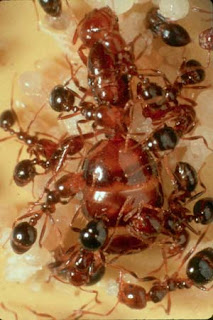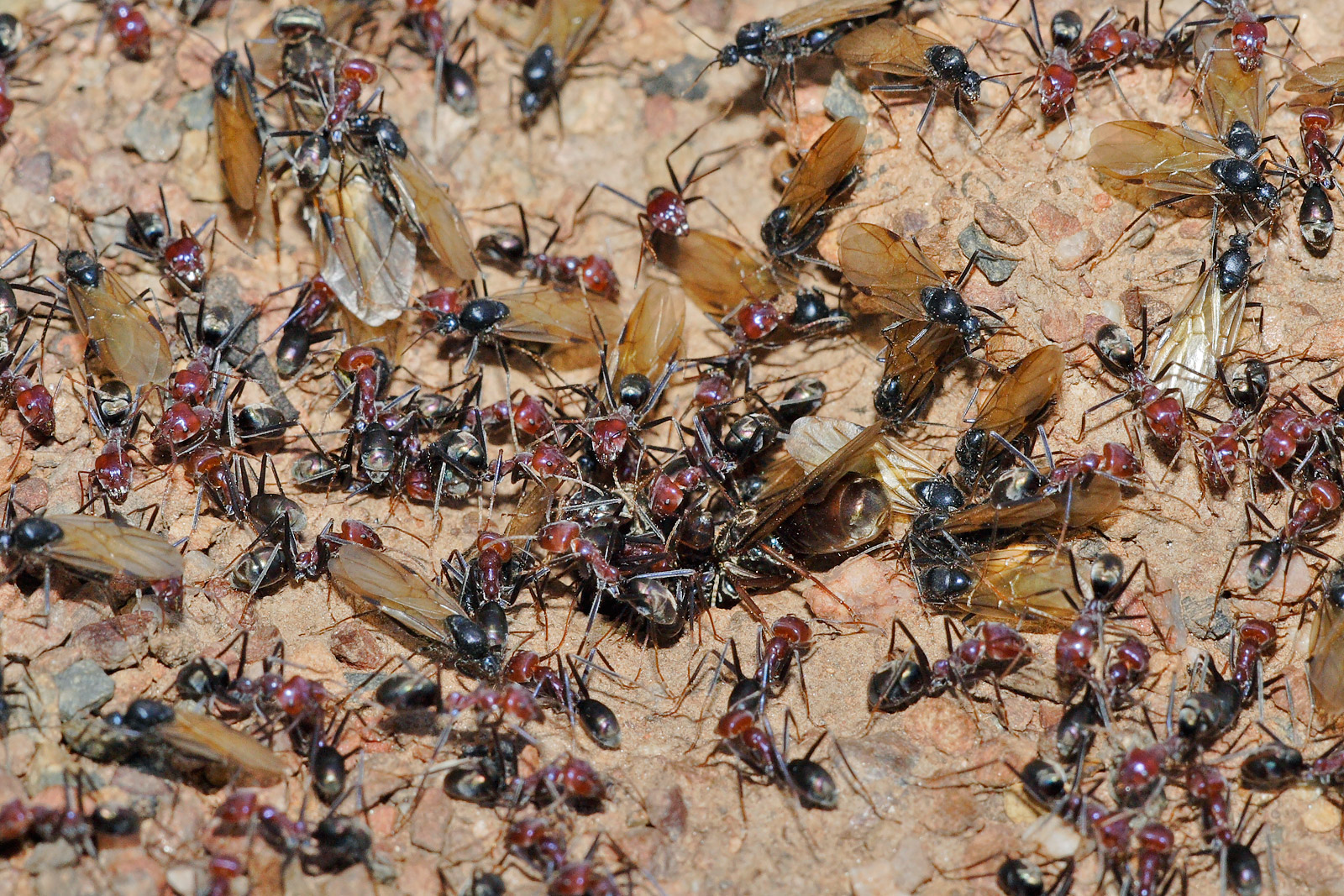Fire Ants are called fire ants because they sting. They feel like a burning fire. Some ants sting, many ants bite. These ants sting.
Solenopsis gemminata: The Tropical Fire Ant
One of them is called Solenopsis geminata, the Tropical Fire Ant. It is found on Saipan and Guam. I likes beaches. These ants are found in swarms around their nests. They nest in the ground. They sting as soon as they are touched, and hurt alot.Notice the stinger on this Solenopsis geminata!!
Like a huge exclamation point!
This ant is found in all of the places with yellow dots. In many of these places it is an unwelcome invader.
The queen of a fire ant is much bigger than the workers
 |
| S. geminata at the opening of a nest |
 |
| A related species on a grasshopper. |
 |
| A nest mound of S. geminata |
- On Guam, evidence suggests Solenpsis geminata is one of the ants that were significant factors in reducing populations
of native butterflies.
- The most important
species attacking eggs were Monomorium floricola,
Solenopsis geminata, and Tapinoma minutum. The
most commonly observed predators attacking butterfly
larvae were T. minutum, S. geminata, and
Technomyrmex albipes.
The Red Imported Fire Ant
But another one is far more dangerous: Solenopsis invicta. This is a smaller fire ant that has been moving through the United States, invading new territory. This ant is an invader in the United States.
 |
| Solenopsis invicta |
It is harmful to Turtles, Birds, Butterflies, and many other species, especially when it is found in the wrong place.
The Electric Ant, or "Little Fire Ant" is very little.
Yet another fire ant is called the Electric Ant, or "Little Fire Ant." The scientific name is Wasmania auropunctata. Here is one of the tiny fire ants stinging a person.The name, electric ant (or little fire ant) derives from the ant's painful sting relative to its size.[7] This ant eats good insects and eliminates spiders on some islands. They also eats hatchling tortoises.
They can eliminate spiders and other insects. It attacks the eyes of tortoises.
On Guam this ant is terrible:
“What this ant does is that it swarms and pretty much eats all of the animals, all of the small insects, the small snails, lizzards, geckos. It pretty much makes the forest a wasteland,”
Here's a little video about the little fire ant in Hawaii:
Invasions
They are like weeds---THEY GO WHERE THEY DO NOT BELONG. They are invading Americaand these ants are invadings islands, and even on continents. They are so aggressive that they have been rapidly moving all over the United States. On islands they also
In Texas they are in the lawns.
Fire Ants are Harmful
Here's something
Hatching sea turtles are particularly vulnerable to attack by ants
because hatchlings typically take from several hours to several
days after pipping before they emerge from their nests. During
this time, ants may invade the nests & attack trapped hatchlings.
Ants also sting hatchlings as they exit the nest. Hatchlings may
die as a direct result of the ant stings, or as an indirect result,
due to impairment caused by stings, particularly stings to their
eyes.
Several predatory ant species, notably Solenopsis geminata and
Solenopsis invicta , are known to attack and kill hatchlings of
ground-nesting birds and reptiles. Here, we surveyed ants along a sea
turtle nesting beach on St. Croix, USVI to evaluate the prevalence of
predatory ants.
Wasmannia auropunctata .. is blamed for reducing species diversity, reducing overall abundance of flying and tree-dwelling insects, and eliminating arachnid populations. It is also known for its painful stings. On the Galápagos, it eats the hatchlings of tortoises and attacks the eyes and cloacae of the adult tortoises. It is considered to be perhaps the greatest ant species threat in the Pacific region.They also compete with native species, and sometimes drive them away.
Winged ants are called "Reproductives"
 |
| A winged female flies starts a new colony as the new Queen. |
Fire ants are very typical of ants in general. In addition to workers and a queen, mature colonies contain males and females capable of flight and reproduction. These individuals are generally called “reproductives.” The average colony can produce about 4,500 reproductives per year. On a warm day, usually one or two days following a rain, the workers open holes in the nest through which the reproductives exit for a mating flight. Mating takes place 300' to 800' in the air. Mated females (are attracted to shiny surfaces) descend to the ground, up to 12 miles away, break off their wings, and search for a place to dig the founding nest, a vertical tunnel 2" to 5" deep. They seal themselves off in this founding nest to lay eggs and to rear their first brood of workers. During this period they do not feed, instead utilizing reserves stored in their bodies. The first worker brood takes about a month to develop; these are the smallest individuals in the entire colony cycle
The female breaks off her wings to become the Queen of a new colony.
After finding a new nest site, the female breaks off her wings and seals herself into the new nest, where she lay eggs for the first group of worker ants. This takes a month.The female "queen" ants will fly a long distance, during which they will mate with at least one winged male from another nest. Once mated, the "queen" will attempt to find a suitable area to start a colony and, once found, detach her wings.
A Queen can live many years. In some species queens can live 30 years.





